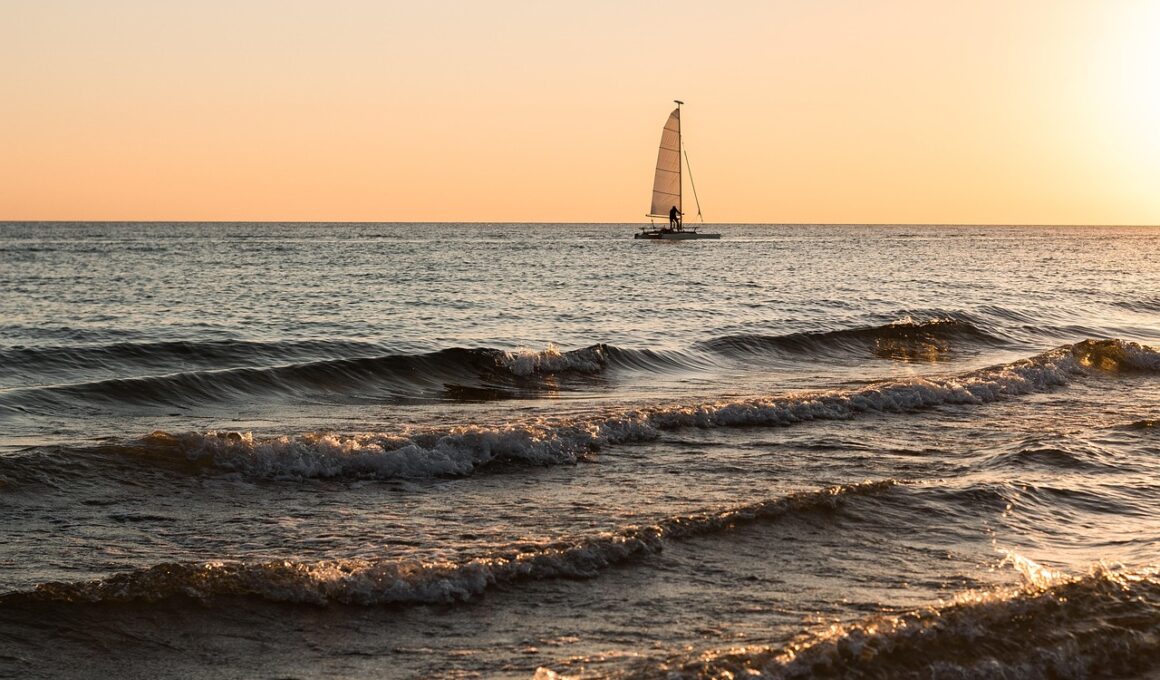The History and Evolution of Sailing
Sailing has a profound and rich history that spans thousands of years, starting from ancient civilizations. Early sailors depended on wind to propel their vessels across waterways, primarily for trade, fishing, and exploration. The first sailing boats were constructed using local materials like reeds and wood. These simple vessels gradually evolved in design and functionality, establishing vital sea routes for commerce. By around 3000 BC, Egyptians were already using sailboats on the Nile, marking a significant advancement in sailing technology. Sailing’s growth continued through cultures around the Mediterranean, including the Phoenicians. Their expertise in navigation and shipbuilding contributed substantially to the spread of sailing as a worldwide practice. As sailing technology advanced, larger ships capable of carrying cargo became prevalent from the 9th century AD onward. Innovations like the lateen sail allowed for better wind maneuverability, significantly improving navigation and opening new trade routes. This rich history reflects the journey of human ingenuity and adaptation to the natural elements, signifying sailing as not just a mode of transport but a pivotal chapter in global development.
The Golden Age of Sailing
The Golden Age of Sailing, occurring during the 15th to 18th centuries, ushered in remarkable developments in maritime navigation and shipbuilding. This period was characterized by transatlantic exploration, maritime trade expansion, and colonialism. Notably, explorers like Christopher Columbus and Vasco da Gama undertook grand voyages, fueled by advances in sailing technology. These explorations connected different parts of the globe, allowing for exchanges of goods, cultures, and ideas. The introduction of new ships, such as the caravel and galleon, demonstrated significant advancements in design for speed and cargo capacity. These vessels were equipped with enhanced sails and rigging systems that improved handling at sea. This era also saw the development of celestial navigation techniques, enabling sailors to determine their position using the stars. Additionally, the invention of the magnetic compass facilitated more accurate routing. This proliferation of maritime activity not only transformed economies but also altered social dynamics, leading to a complex interplay of power among nations. As such, the Golden Age of Sailing remains a vital phase in understanding maritime history and its influence on global society.
Throughout the 19th century, sailing underwent revolutionary changes as the Industrial Revolution took hold, sparking significant advancements in maritime technology. This era marked the transition from traditional sailing ships to more mechanized vessels, notably the introduction of steamships. Steam-powered boats began to supplement traditional sailing vessels, allowing for more consistent travel regardless of wind conditions. Despite this innovation, sailing continued to hold importance for both recreational pursuits and commercial ventures. The rise of yacht racing during this period signified the beginning of sailing as a popular sport, with clubs being established to host regattas. Sailing technology further advanced with the development of iron and steel hulls, which provided greater durability compared to wooden crafts. Moreover, the rise of navigation instruments, such as sextants and chronometers, vastly improved navigational accuracy. The late 19th century paved the way for modern sailing practices, influencing both amateur and professional sailors engaged in competitions and oceanic explorations. So, while steam power began to dominate marine transportation, sailing retained its essential place in both history and contemporary practices.
Modern Sailing and Technological Advances
In the 20th and 21st centuries, modern sailing has continued to evolve with technological advancements that enhance performance and safety. Innovations in materials, such as fiberglass and carbon fiber, contributed to lighter and faster sailboats. The introduction of computer navigation systems and GPS technology revolutionized how sailors navigate, providing precise positioning and track routes. Sailboat designs have also become more sophisticated, incorporating hydrofoils that lift boats above water, reducing drag, and increasing speed. Furthermore, the emergence of racing circuits, such as the America’s Cup, has led to intense competition and the development of cutting-edge sailing technologies. These innovations attract not only professional sailors but also enthusiasts interested in leisure sailing. Environmental concerns have encouraged the design of eco-friendly boats, promoting sustainability in sailing practices. Today, sailing is not only a sport but also a means of fostering community and appreciation for marine environments. The continued growth of sailing schools and clubs across the globe showcases the enduring appeal of this ancient practice in contemporary society. Thus, modern sailing exemplifies how tradition and innovation can coexist harmoniously.
Sailing today encompasses various disciplines, from leisurely cruising to competitive racing, providing opportunities for all skill levels. The growth of sailing as a recreational pastime has led to the establishment of countless organizations worldwide, which promote sailing education and safety. Environmental awareness campaigns aim to protect marine ecosystems, emphasizing responsible sailing practices that safeguard our waters. Events such as sailing festivals and regattas draw participants and spectators alike, highlighting the sport’s vibrant culture. Moreover, advancements in sailing technology have made it more accessible to people with disabilities through adaptive sailing programs. These initiatives encourage inclusivity, fostering social connections among local sailing communities. Furthermore, modern sailing significantly contributes to economy through tourism, attracting enthusiasts to picturesque coastlines and historically rich ports. The impressive variety of sailing vessels today, from small dinghies to luxurious yachts, serves to inspire interest in sailing among diverse audiences. Learning to sail remains a popular aspiration, with both young and old individuals seeking instruction and training. Thus, the interconnectedness of tradition, sport, and environmental stewardship signifies sailing’s continued relevance in contemporary culture.
The Future of Sailing
As we look towards the future of sailing, numerous trends hint at an exciting evolution within the sport and industry. Environmental sustainability continues to drive innovation, as the sailing community strives to minimize ecological footprints through cleaner energy solutions. For instance, solar panels and electric propulsion systems are becoming common features on new vessels, showcasing the industry’s commitment to green practices. Moreover, virtual reality and simulation technologies are transforming how sailors learn and practice their skills, making sailing accessible to a broader audience. This technological integration could help demystify sailing, allowing newcomers to build confidence before stepping on the water. Additionally, increased emphasis on mental health and wellness in outdoor sports highlights sailing’s potential as a therapeutic activity, promoting mindfulness and relaxation. Furthermore, international sailing competitions, such as the World Sailing Championships, foster camaraderie and exchange among nations, reinforcing sailing’s role in cultural diplomacy. As global challenges persist, sailing will undoubtedly adapt, reflecting changes in society while maintaining its essential character. By embracing advancements while honoring tradition, the future of sailing may be brighter than ever, ensuring its place in maritime history.
In summary, the history and evolution of sailing illustrate a fascinating journey marked by human ingenuity, exploration, and adaptation. From its humble origins to becoming a modern sport, sailing has continually transformed through the ages, reflecting broader societal changes and technological advancements. The Golden Age illustrated the importance of exploration and trade, while the Industrial Revolution signaled a shift toward mechanization and globalization. Today, we face new challenges and opportunities as we innovate and strive for sustainability. The vibrant sailing community continues to inspire individuals, creating social bonds through shared experiences on the water. With user-friendly technologies and adaptive practices, sailing is evolving to ensure accessibility for people of all backgrounds. As participants in this journey, sailors carry forward traditions while also exploring new horizons. By navigating the waters responsibly, respecting marine environments, and fostering inclusivity, we can ensure that the legacy of sailing continues for generations to come. Ultimately, sailing enriches lives by offering adventure and community, highlighting the significance of our connection to the sea.
Moreover, as this ancient practice ushers into the future, innovations are expected to redefine the sailing experience, enhancing the relationship between humanity and the ocean. The integration of technology, sustainability, and inclusivity within sailing not only reshapes the sport but also builds a legacy that embraces both heritage and modernization. The advancements made by previous generations serve to inspire contemporary sailors and enthusiasts alike, ensuring that the passion for sailing remains alive, vibrant, and forward-thinking. The call to protect our oceans sounds louder than ever, urging every sailor to partake in preserving these delightful waterways for future explorers. The essence of sailing embodies adventure, learning, skill, and collaboration, remaining a beacon for aspiring sailors. Communities unite over shared challenges and triumphs, building friendships through collective experiences. As we sail into this promising future, the spirit of sailors past lives on, driving us forward as stewards of the sea and dedicated practitioners of an art that continues to evolve. Indeed, sailing represents a timeless endeavor where the thrill of harnessing nature intertwines with the values of respect, adventure, and fellowship.


